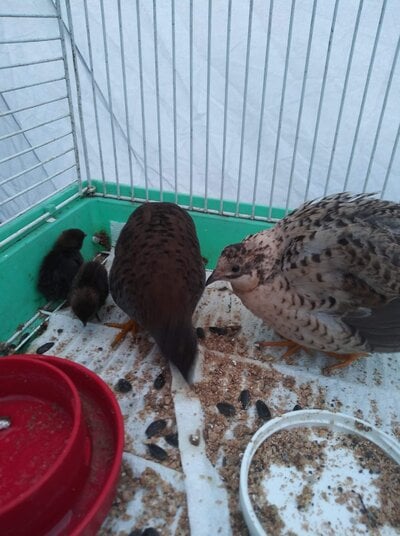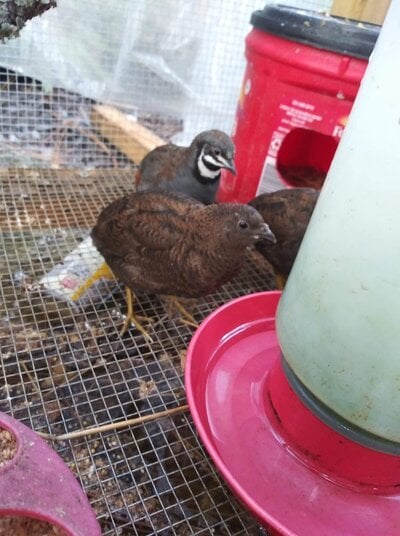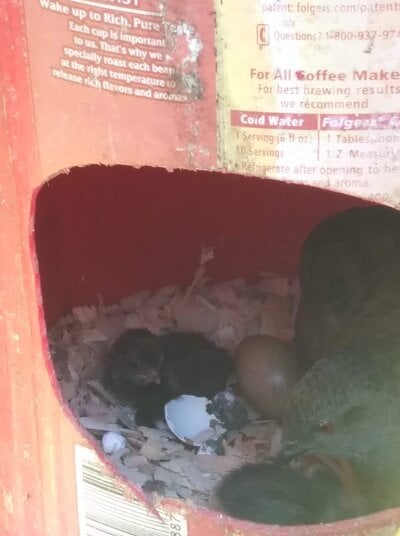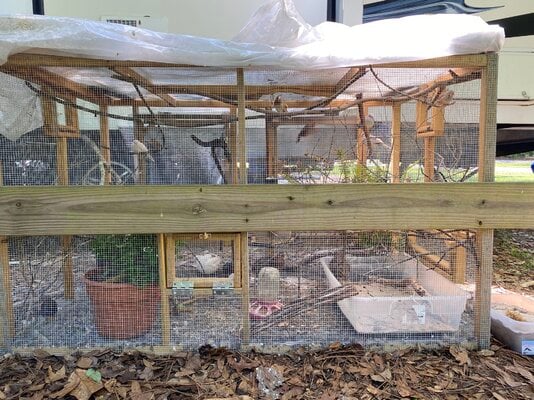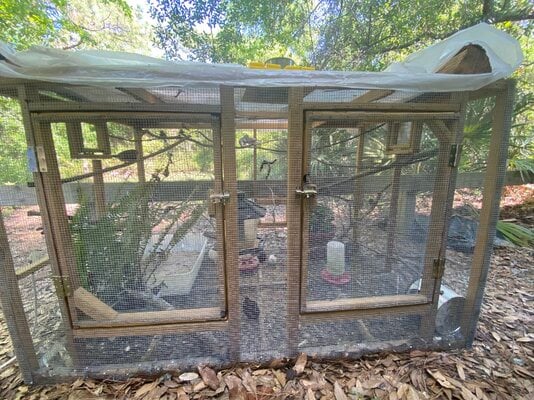Johanna Lee
Chirping
- Apr 17, 2020
- 14
- 22
- 74
The Full Guide to King Quail
About King Quails:
Although commonly referred to as "Button quail" in captivity the true name of these little birds is King quail. The True Button quail isn't even a quail- They are currently placed with the Charadriiformes, Which are shorebirds. Other common names for King quail include, Blue-breasted quail, Asian Blue quail, Or Chinese Painted quail. They are the smallest true quail, And in the wild are native to parts of Asia, Australia, And China. There are 10 different subspecies. The species get's it's "blue" and "painted" names due to the wild/typical type coloring of the male- Black and white facial markings, A blue chest, red underparts, And a brown back. The wild type female is camouflaged brown above, With a beige underside, Barred with brown. Her face and throat are marked with orangeish beige.
Size: 4-5 inches long and weigh around 0.99-1.4 ounces fully grown.
Lifespan: 3-6 years average. Can live up to 15 years. Age depends very heavily on genetics and how well they are cared for.
Caging/Enclosures:
Like most quail, They need a decent amount of space. The cage should be fairly long to allow for lots of back and forth walking. I recommend a minimum of 36"L x 24"W x 24"H for a single pair. The cage should be increased by 1/2 that size per added pair.
Although they are not perching birds, Overhead space is required in case of a spook. And sometimes they'll get excited and will enjoy some space to flutter into the air. When spooked, They will jump straight up into the air which in some cases can result in a severe injury or even kill the bird. This most often is not an issue however if you are worried you can hang loose netting 3 inches or so below the top of the cage to act as a cushion for a bird. Many people keep King quail in aquariums however this is not really healthy for the bird. Musty air will stay and be bad for the birds lungs and the lack of height is more likely to result in an injury. Since for most tanks the lid is at the top and most don't have a side sliding door it also makes birds more likely to spook and jump out when trying to replace food or water. The best option is usually to build your own cage, As it gives you control over size and accessibility. For a mesh cage 1/2 inch hardware cloth is suitable for the walls and roof, & 1/4 inch should be used for the floor. If you plan on having the pair raise babies, 1/4 inch should be used for the walls as well (Or at least the bottom 4 inches). Another better option is to have a solid flooring. This can be done by building the bottom frame out of wood or some sort of plastic sheet with a sand or gravel flooring. Natural soil can also be used. Quail also enjoy things to hide under, So in the case of natural soil, Safe plants can be added to the cage for a more natural look. Keep in mind, The cage should be fairly heavily planted as quail like to eat certain parts. You can supplement sprout and other greens to distract from the other plants. Safe Fake plants can also be used. They also enjoy climbing on occasion so ledges can be placed along a wall at varying heights, Or a few old stumps can be added as well as rocks. They should also have a large dustbath filled with either sand or natural soil. (Do not use if pesticides have been used on or near the soil)
Tip for outdoor enclosures: If temps go below 60° fahrenheit the birds must be supplied with a heat lamp in a draft free corner. The enclosure should also preferable be covered with a sheet or thin plastic for the night.
Feeding / Watering: Can be fed Hen layer, However Gamebird starter is more appropriate especially if you want eggs as they need higher protein than chickens for example. Can be supplemented with a finch seed mix as well as greens, sprouted seeds, and occasional mealworms. Feeding only seed can result in overweight birds. Birds should have access to fresh water at all times. A normal chick waterer can be used for adult birds.
Sexing:
In many color types the male will have visible bib markings. In color types without a bib, The blue chest or red vent/underside area can be used to tell males from females. Some color types such as pure whites need to be sexed by behavior/sounds. A way to test a mature birds gender is to sprinkle seed or mealworms on the ground. He will pick them up and call to the females/his mate. At a year or so of age, Most males will aquire blood red eyes.
(Bibless VS bibbed male)


Breeding:
When breeding King quail, They should be kept in pairs, Each in it's own enclosure for best results. Trios can also work well, But care must be taken that the male doesn't become aggressive towards the second female, As some males do not want a second mate. Birds will often start laying as early as 7 weeks of age however it is best to wait until about 3 months of age before breeding.
Hatching & Raising Chicks:
There are a few different methods to hatching King quail eggs, The most common being the incubator method. Other methods include Natural (parent raised), Or fostering. Eggs generally take 16 days to hatch.
Incubator Method:
For the first 13 days Humidity should be kept around 45-50% and if an egg turner is not used, The eggs should be turned 3-4 times a day. On the 13th day they should go into "lockdown". At this point the Humidity should be upped to around 70% and the incubator remains closed until most of the eggs have hatched. Chicks should be put into the brooder once fully/mostly dry and fluffy.
(Incubator chicks, About half an hour old & at a few hours old)


Natural Method:
This method may prove tricky, As many hens will not go broody. A large cage with lots of natural (or natural looking) cover and a good diet will greatly increase chances of broodiness. The nest should remain unbothered if possible or it may be abandoned. Males can stay with the hen but should be kept a close eye on, as some males will be aggressive towards the chicks.A male should be removed immedietly if any signs of aggression present themselves (Throwing chicks around by the feet, Excessive pecking or chasing, Large areas of feathers missing, Or other injuries). Often the male will assist in incubation and or chick raising while other males may ignore their offspring completely. In the case of a mesh floor caging, The floor should be covered with paper towels until the chicks are about 2 weeks old. The hen will take care of teaching the chicks to eat and drink as well as brooding them. If chicks are found dead or dying, Or the mother is Very obviously ignoring them or being aggressive the babies should be separated into a brooder.
Tip: To start with, One egg should be left in the nest until the hen shows signs of broodiness. It is best to leave the egg that was laid the day before and collect it on the 2nd day once a new egg was laid (they can be lightly marked with pencil so you know which egg to collect as the new one will be unmarked). Once the hen starts showing signs of broodiness such as sitting longer throughout the day and being poofy and angry you should stop collecting the eggs. If she has stopped laying at this point and is still sitting throughout the day you can add back several of the newer eggs you collected previously (clutch size should be 5-8 however for a first time mother 3-4 is better)
(First time Broody hen on her 3 eggs)

(Out of 3 eggs, 2 hatched. Due to the cage type the chicks were moved at a few hours old once they began trying to leave the nest. The family was moved to a small cage for the first week of the chicks life. Far left is hatch day, Middle is 2-3 days of age, Right is the 2 sisters at about 4 months and back in the flock.)



Fostering:
For this method, Other quail species can be used or even bantam chicken hens. In the case of chickens the smallest breed possible should be used as King quail chicks are much smaller than other quail (only about half the size of a Coturnix for example). For chickens it is best to sneak the eggs under and remove her own eggs. She should also be fully separated from the flock as other hens will eat the eggs and may even eat the chicks once hatched. It is important to check on the chicks regularly for the first 2 days or so to ensure the foster truly accepts them.
(No photos of fostering available, However I had great success using my SilkieXcochin crosses to hatch and raise Coturnix Quail.)
Feeding/Watering Chicks:
Chicks should be fed gamebird starter supplemented with boiled egg, dried mealworms, or eggfood. Because of their tiny size, Crumble needs to be crushed some more. Boiled eggs should be mashed and given in small amounts for the first 2 weeks for added protien. Egg food can be mixed with the crumble or mashed into the egg. Mealworms can also be crushed and given. They cannot reach into normal feeders until around a week of age so food should be given on a flat dish such as a tupperware lid or something similar. For chicks a quail waterer should be used as a normal chick waterer is too big even with gravel or marbles added. A normal chick waterer can be used once they reach a week or two of age.
Into the Brooder:
The brooder should have a warm and cooler end. The area under the heat lamp should be around 95° Fahrenheit the first few days and be decreased by about 5° every week. Once the chicks are fully feathered they can go without the heat lamp during the day as long as the temperature remains between 70-80°. The water and food should be on the colder end of the incubator. A small amount of apple cider vinegar can be added to the water to boost immune health for the chicks. Personally, I prefer a red bulb as it allows the chicks to sleep better. The packaging for bulbs will often tell you what distance gives a certain temperature depending on wattage.
(Day old & 4 day old chicks in a small temporary brooder before pickup by a customer)

Cagemates:
King quail can be kept with a variety of other birds such as Finches or certain Doves. If breeding the Finches care should be taken that they do not begin to pluck the quails feathers (or those of other cage mates) for nest lining. This can usually be prevented by providing feathers from an alternate source, Or other soft materials such as tissue strips. Doves or finches should have an alternate feeder out of the quails reach to supply seed. Personally, I have kept Society, Zebra, Shaft-tailed, And Orange cheeked waxbill finches with my quail as well as Diamond doves. Zebras are more likely to pluck other birds for their feathers.
(Diamond doves. Zebra finch hen in background) (Society finch Male. Can only be sexed by singing/behavior) (Zebra Finch Pair)


 View attachment 2907257
View attachment 2907257
More images:
(Wild Pair- Captive wild type birds are similar)

(Captive Wild type pair, Female hidden in background. Male has not yet attained red eyes.)

(One of the naturally raised chicks preening her flockmate. About 6 weeks old and aquired chestnut coloration as she aged.)

(Chestnut male (father of above) at a younger age before being fully chestnut)

(Sept 2021 has been fully chestnut for a few years)

(Wild type male at a few months old. His eyes had begun to turn red here)

About King Quails:
Although commonly referred to as "Button quail" in captivity the true name of these little birds is King quail. The True Button quail isn't even a quail- They are currently placed with the Charadriiformes, Which are shorebirds. Other common names for King quail include, Blue-breasted quail, Asian Blue quail, Or Chinese Painted quail. They are the smallest true quail, And in the wild are native to parts of Asia, Australia, And China. There are 10 different subspecies. The species get's it's "blue" and "painted" names due to the wild/typical type coloring of the male- Black and white facial markings, A blue chest, red underparts, And a brown back. The wild type female is camouflaged brown above, With a beige underside, Barred with brown. Her face and throat are marked with orangeish beige.
Size: 4-5 inches long and weigh around 0.99-1.4 ounces fully grown.
Lifespan: 3-6 years average. Can live up to 15 years. Age depends very heavily on genetics and how well they are cared for.
Caging/Enclosures:
Like most quail, They need a decent amount of space. The cage should be fairly long to allow for lots of back and forth walking. I recommend a minimum of 36"L x 24"W x 24"H for a single pair. The cage should be increased by 1/2 that size per added pair.
Although they are not perching birds, Overhead space is required in case of a spook. And sometimes they'll get excited and will enjoy some space to flutter into the air. When spooked, They will jump straight up into the air which in some cases can result in a severe injury or even kill the bird. This most often is not an issue however if you are worried you can hang loose netting 3 inches or so below the top of the cage to act as a cushion for a bird. Many people keep King quail in aquariums however this is not really healthy for the bird. Musty air will stay and be bad for the birds lungs and the lack of height is more likely to result in an injury. Since for most tanks the lid is at the top and most don't have a side sliding door it also makes birds more likely to spook and jump out when trying to replace food or water. The best option is usually to build your own cage, As it gives you control over size and accessibility. For a mesh cage 1/2 inch hardware cloth is suitable for the walls and roof, & 1/4 inch should be used for the floor. If you plan on having the pair raise babies, 1/4 inch should be used for the walls as well (Or at least the bottom 4 inches). Another better option is to have a solid flooring. This can be done by building the bottom frame out of wood or some sort of plastic sheet with a sand or gravel flooring. Natural soil can also be used. Quail also enjoy things to hide under, So in the case of natural soil, Safe plants can be added to the cage for a more natural look. Keep in mind, The cage should be fairly heavily planted as quail like to eat certain parts. You can supplement sprout and other greens to distract from the other plants. Safe Fake plants can also be used. They also enjoy climbing on occasion so ledges can be placed along a wall at varying heights, Or a few old stumps can be added as well as rocks. They should also have a large dustbath filled with either sand or natural soil. (Do not use if pesticides have been used on or near the soil)
Tip for outdoor enclosures: If temps go below 60° fahrenheit the birds must be supplied with a heat lamp in a draft free corner. The enclosure should also preferable be covered with a sheet or thin plastic for the night.
Feeding / Watering: Can be fed Hen layer, However Gamebird starter is more appropriate especially if you want eggs as they need higher protein than chickens for example. Can be supplemented with a finch seed mix as well as greens, sprouted seeds, and occasional mealworms. Feeding only seed can result in overweight birds. Birds should have access to fresh water at all times. A normal chick waterer can be used for adult birds.
Sexing:
In many color types the male will have visible bib markings. In color types without a bib, The blue chest or red vent/underside area can be used to tell males from females. Some color types such as pure whites need to be sexed by behavior/sounds. A way to test a mature birds gender is to sprinkle seed or mealworms on the ground. He will pick them up and call to the females/his mate. At a year or so of age, Most males will aquire blood red eyes.
(Bibless VS bibbed male)
Breeding:
When breeding King quail, They should be kept in pairs, Each in it's own enclosure for best results. Trios can also work well, But care must be taken that the male doesn't become aggressive towards the second female, As some males do not want a second mate. Birds will often start laying as early as 7 weeks of age however it is best to wait until about 3 months of age before breeding.
Hatching & Raising Chicks:
There are a few different methods to hatching King quail eggs, The most common being the incubator method. Other methods include Natural (parent raised), Or fostering. Eggs generally take 16 days to hatch.
Incubator Method:
For the first 13 days Humidity should be kept around 45-50% and if an egg turner is not used, The eggs should be turned 3-4 times a day. On the 13th day they should go into "lockdown". At this point the Humidity should be upped to around 70% and the incubator remains closed until most of the eggs have hatched. Chicks should be put into the brooder once fully/mostly dry and fluffy.
(Incubator chicks, About half an hour old & at a few hours old)
Natural Method:
This method may prove tricky, As many hens will not go broody. A large cage with lots of natural (or natural looking) cover and a good diet will greatly increase chances of broodiness. The nest should remain unbothered if possible or it may be abandoned. Males can stay with the hen but should be kept a close eye on, as some males will be aggressive towards the chicks.A male should be removed immedietly if any signs of aggression present themselves (Throwing chicks around by the feet, Excessive pecking or chasing, Large areas of feathers missing, Or other injuries). Often the male will assist in incubation and or chick raising while other males may ignore their offspring completely. In the case of a mesh floor caging, The floor should be covered with paper towels until the chicks are about 2 weeks old. The hen will take care of teaching the chicks to eat and drink as well as brooding them. If chicks are found dead or dying, Or the mother is Very obviously ignoring them or being aggressive the babies should be separated into a brooder.
Tip: To start with, One egg should be left in the nest until the hen shows signs of broodiness. It is best to leave the egg that was laid the day before and collect it on the 2nd day once a new egg was laid (they can be lightly marked with pencil so you know which egg to collect as the new one will be unmarked). Once the hen starts showing signs of broodiness such as sitting longer throughout the day and being poofy and angry you should stop collecting the eggs. If she has stopped laying at this point and is still sitting throughout the day you can add back several of the newer eggs you collected previously (clutch size should be 5-8 however for a first time mother 3-4 is better)
(First time Broody hen on her 3 eggs)
(Out of 3 eggs, 2 hatched. Due to the cage type the chicks were moved at a few hours old once they began trying to leave the nest. The family was moved to a small cage for the first week of the chicks life. Far left is hatch day, Middle is 2-3 days of age, Right is the 2 sisters at about 4 months and back in the flock.)
Fostering:
For this method, Other quail species can be used or even bantam chicken hens. In the case of chickens the smallest breed possible should be used as King quail chicks are much smaller than other quail (only about half the size of a Coturnix for example). For chickens it is best to sneak the eggs under and remove her own eggs. She should also be fully separated from the flock as other hens will eat the eggs and may even eat the chicks once hatched. It is important to check on the chicks regularly for the first 2 days or so to ensure the foster truly accepts them.
(No photos of fostering available, However I had great success using my SilkieXcochin crosses to hatch and raise Coturnix Quail.)
Feeding/Watering Chicks:
Chicks should be fed gamebird starter supplemented with boiled egg, dried mealworms, or eggfood. Because of their tiny size, Crumble needs to be crushed some more. Boiled eggs should be mashed and given in small amounts for the first 2 weeks for added protien. Egg food can be mixed with the crumble or mashed into the egg. Mealworms can also be crushed and given. They cannot reach into normal feeders until around a week of age so food should be given on a flat dish such as a tupperware lid or something similar. For chicks a quail waterer should be used as a normal chick waterer is too big even with gravel or marbles added. A normal chick waterer can be used once they reach a week or two of age.
Into the Brooder:
The brooder should have a warm and cooler end. The area under the heat lamp should be around 95° Fahrenheit the first few days and be decreased by about 5° every week. Once the chicks are fully feathered they can go without the heat lamp during the day as long as the temperature remains between 70-80°. The water and food should be on the colder end of the incubator. A small amount of apple cider vinegar can be added to the water to boost immune health for the chicks. Personally, I prefer a red bulb as it allows the chicks to sleep better. The packaging for bulbs will often tell you what distance gives a certain temperature depending on wattage.
(Day old & 4 day old chicks in a small temporary brooder before pickup by a customer)
Cagemates:
King quail can be kept with a variety of other birds such as Finches or certain Doves. If breeding the Finches care should be taken that they do not begin to pluck the quails feathers (or those of other cage mates) for nest lining. This can usually be prevented by providing feathers from an alternate source, Or other soft materials such as tissue strips. Doves or finches should have an alternate feeder out of the quails reach to supply seed. Personally, I have kept Society, Zebra, Shaft-tailed, And Orange cheeked waxbill finches with my quail as well as Diamond doves. Zebras are more likely to pluck other birds for their feathers.
(Diamond doves. Zebra finch hen in background) (Society finch Male. Can only be sexed by singing/behavior) (Zebra Finch Pair)
More images:
(Wild Pair- Captive wild type birds are similar)
(Captive Wild type pair, Female hidden in background. Male has not yet attained red eyes.)
(One of the naturally raised chicks preening her flockmate. About 6 weeks old and aquired chestnut coloration as she aged.)
(Chestnut male (father of above) at a younger age before being fully chestnut)
(Sept 2021 has been fully chestnut for a few years)
(Wild type male at a few months old. His eyes had begun to turn red here)
Attachments
Last edited:

